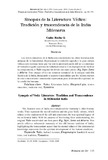Sinopsis de la literatura Védica: tradición y trascendencia de la India Milenaria

Data
2009-08-11Autor
Palabras Clave
Vedas, Literatura India, Bhagavad-gita, Textos sánscritos, Tradición oral, VyasadevaVedas, Indian literature, Bhagavad-gita, Sanskrit & sacred texts, Oral tradition, Vyasadeva
Metadatos
Mostrar registro completoResumo
Los textos sánscritos de la India son considerados las obras literarias más antiguas de la humanidad. Representan la
tradición sagrada y la gran cultura védica cuyo mensaje tiene que ver con la autorrealización del ser y constituye el
verdadero legado espiritual de la India milenaria. Con el propósito de facilitar su comprensión, el Veda original fue divido en cuatro partes: Rig, Yajur, Sama y Atharva. Este ensayo ofrece un resumen sustancial de la antigua tradición literaria de la India, destacando el aspecto trascendente que los valores eternos de este conocimiento inmemorial representan para el desarrollo espiritual de la condición humana.
Colecciones
Información Adicional
| Otros Títulos | Synopsis of vedic literature: tradition and transcendence in Millennial India |
| Correo Electrónico | crocha@binstitute.org |
| ISSN | 1856-6812 |
| Resumen en otro Idioma | The Sanskrit texts of India are considered the humanity’s older literary works. They represent the sacred tradition and the great Vedic culture, which relates to the realization of the self and constitutes the true spiritual legacy of the millennial India. With the purpose of facilitating their understanding, the original Veda was divided into four parts: Rig, Yajur, Sama and Atharva. This article offers a substantial summary of the old literary tradition of India, highlighting the transcendent aspect that the eternal values of this immemorial knowledge represents for the spiritual development of the human condition. |
| Colación | 117-141 |
| Periodicidad | semestral |
| Publicación Electrónica | Revista Humania del Sur |
| Sección | Revista Humania del Sur: Debate |





